- Home
- About
- Map
- Trips
- Bringing Boat West
- Migration West
- Solo Motorcycle Ride
- Final Family XC Trip
- Colorado Rockies
- Graduates' XC Trip
- Yosemite & Nevada
- Colorado & Utah
- Best of Utah
- Southern Loop
- Pacific Northwest
- Northern Loop
- Los Angeles to NYC
- East Coast Trips
- Martha's Vineyard
- 1 Week in Quebec
- Southeast Coast
- NH Backpacking
- Martha's Vineyard
- Canadian Maritimes
- Ocracoke Island
- Edisto Island
- First Landing '02
- Hunting Island '02
- Stowe in Winter
- Hunting Island '01
- Lake Placid
- Chesapeake
- Provincetown
- Hunting Island '00
- Acadia in Winter
- Boston Suburbs
- Niagara Falls
- First Landing '99
- Cape Hatteras
- West Coast Trips
- Utah Off-Roading
- Maui
- Mojave 4WD Course
- Colorado River Rafting
- Bishop & Death Valley
- Kauai
- Yosemite Fall
- Utah Off-Road
- Lost Coast
- Yosemite Valley
- Arizona and New Mexico
- Pescadero & Capitola
- Bishop & Death Valley
- San Diego, Anza Borrego, Joshua Tree
- Carmel
- Death Valley in Fall
- Yosemite in the Fall
- Pacific Northwest
- Utah Off-Roading
- Southern CA Deserts
- Yosemite & Covid
- Lake Powell Covid
- Eastern Sierra & Covid
- Bishop & Death Valley
- Central & SE Oregon
- Mojave Road
- Eastern Sierra
- Trinity Alps
- Tuolumne Meadows
- Lake Powell Boating
- Eastern Sierra
- Yosemite Winter
- Hawaii
- 4WD Eastern Sierra
- 4WD Death Valley +
- Southern CA Deserts
- Christmas in Tahoe
- Yosemite & Pinnacles
- Totality
- Yosemite & Sierra
- Yosemite Christmas
- Yosemite, San Diego
- Yosemite & North CA
- Seattle to Sierra
- Southwest Deserts
- Yosemite & Sierra
- Pacific Northwest
- Yosemite & South CA
- Pacific Northwest
- Northern California
- Southern Alaska
- Vancouver Island
- International Trips
- Index
- Tips
- Books
- Photos/Videos
- Search
- Contact
Joshua Tree National Park, CA
Saturday, November 15, 2014 - 11:30am by Lolo
290 miles and 6 hours from our last stop - 3 night stay
Travelogue
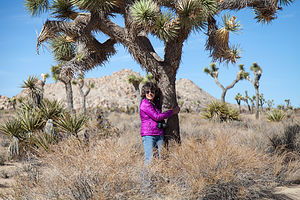 Joshua Tree HuggerContinuing what was becoming a tour of the deserts of the Southwest, we headed south towards Joshua Tree National Park.
Joshua Tree HuggerContinuing what was becoming a tour of the deserts of the Southwest, we headed south towards Joshua Tree National Park.
It was a Saturday, and since Joshua Tree is a popular weekend destination for LA and San Diego residents (it’s only about 2 ½ hours away from both), a phone call confirmed that all the campgrounds in the park were full. So, we drove to Yucca Valley and stayed at the Yucca Valley RV Park, fairly close to the entrance to the park. This would allow us to get one of the first-come, first-served sites the next morning when the weekend crowd left.
We entered the Park the next morning through the Twentynine Palms entrance, stopping at the Visitor Center and taking the time to walk the Oasis of Mara Interpretive Trail, a short ½-mile paved loop with lovely palm trees and other interesting desert flora. Unfortunately, as we learned, this is no longer a true oasis and today must be partially irrigated due to overuse by the town of Twentynine Palms.
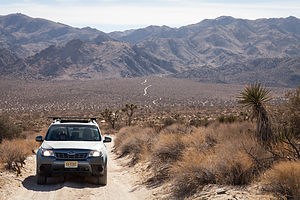 Subaru on 4WD Geology Tour RoadAfter entering the park, we drove straight to the Jumbo Rocks Campground, where we had our choice of sites, because pretty much everyone was packing up and heading out as the weekend came to a close. As we always do, we made several loops through the campground trying to select the perfect site. They all were pretty good, snugly tucked amongst large red boulders – a climber or rock scrambler’s paradise.
Subaru on 4WD Geology Tour RoadAfter entering the park, we drove straight to the Jumbo Rocks Campground, where we had our choice of sites, because pretty much everyone was packing up and heading out as the weekend came to a close. As we always do, we made several loops through the campground trying to select the perfect site. They all were pretty good, snugly tucked amongst large red boulders – a climber or rock scrambler’s paradise.
We haven’t gotten over the novelty yet of having a tow vehicle along, so we’re still thrilled every time we decouple the Subaru from the motorhome to set out on a day of exploration. It has been very liberating. Not only is it less stressful, but it allows us to go places we never could before, especially unpaved roads, of which there are so many in the western parks.
After leaving the campground, we quickly took the left turn off Park Boulevard onto the dirt Geology Tour road and spent the next 2 hours driving through some of the park’s most interesting geological formations.
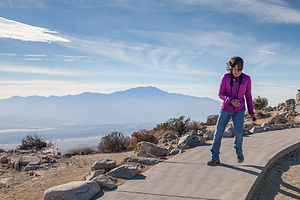 Lolo with Keys View Lookout WindThere are 16 stops along the 18-mile drive, and I made sure Herb listened to me read the description of each from the park brochure. I should have quizzed him at the end, because I am not sure how diligently he was paying attention. He was too busy taking pictures of the fabulous scenery.
Lolo with Keys View Lookout WindThere are 16 stops along the 18-mile drive, and I made sure Herb listened to me read the description of each from the park brochure. I should have quizzed him at the end, because I am not sure how diligently he was paying attention. He was too busy taking pictures of the fabulous scenery.
Although regular two-wheel drive vehicles have to turnaround at Squaw Tank (Stop #9), we forged on in our 4-wheel drive along what became a bumpier, but still very doable road. Although the official Geology Tour Road only went as far as Pleasant Valley, an even more desolate and bumpy road continued on and up through the Little San Bernadino Mountain Range. We dutifully followed our brochure, and headed back out from whence we came, not passing another car our entire drive back. It was pretty awesome.
Back on Park Boulevard, we headed west and took the turnoff for Keys View, an overlook atop the San Bernadino Mountains with panoramic views of the Coachella Valley and mountains beyond. It was pretty spectacular, but so windy that we literally had difficulty standing upright.
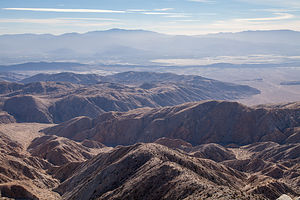 Keys View LookoutSince we are theoretically rock climbers, and Joshua Tree is a very popular rock climbing destination, we decided to spend the rest of the afternoon exploring various climbing areas, and possibly finding something appropriate to climb tomorrow – and by appropriate, I mean easy enough for me. Also, it would have to be something that Herb could set up a top rope on himself, because I have never belayed someone leading a climb before, but only on a top rope. The boys are always there to do that. Where were they when I needed them???
Keys View LookoutSince we are theoretically rock climbers, and Joshua Tree is a very popular rock climbing destination, we decided to spend the rest of the afternoon exploring various climbing areas, and possibly finding something appropriate to climb tomorrow – and by appropriate, I mean easy enough for me. Also, it would have to be something that Herb could set up a top rope on himself, because I have never belayed someone leading a climb before, but only on a top rope. The boys are always there to do that. Where were they when I needed them???
These criteria narrowed our options down significantly. However, we had bought “Best Climbs in Joshua Tree” that morning at the Visitor Center, so we had lots of information about many of the classic climbs in the park, including their difficulty rating and type of climbing (trad, sport, toprope, etc.). We proceeded on our quest for the perfect top-ropable 5.7 or 5.8.
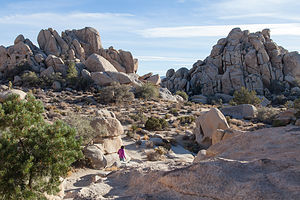 Lolo Hiking Hidden ValleyOur first stop was the Hall of Horrors Wall – that sounds like fun! Seriously, who names these things? We actually found a 5.7 called Lazy Day, which I kind of thought was fate considering the name of our motorhome. We put it on our list of possibilities, but not too high because it was a crack climb, which means having to jam your fingers and/or entire hand into a crack to work your way up the wall – not a type of climbing that is particularly a favorite of ours.
Lolo Hiking Hidden ValleyOur first stop was the Hall of Horrors Wall – that sounds like fun! Seriously, who names these things? We actually found a 5.7 called Lazy Day, which I kind of thought was fate considering the name of our motorhome. We put it on our list of possibilities, but not too high because it was a crack climb, which means having to jam your fingers and/or entire hand into a crack to work your way up the wall – not a type of climbing that is particularly a favorite of ours.
We stopped at Hidden Valley, another very popular climbing area, but for some reason, I can’t remember why, we chose to just do a hike rather than look for climbing options. I think I was getting a bit intimidated by the thought of climbing here. It was a very different type of climbing than I was used to – mostly cracks or slab – not many handholds, which I have come to love. Also, Herb and I have never really climbed just the two of us alone, so this was going to be an interesting challenge, both physically and maritally (if that is even a word).
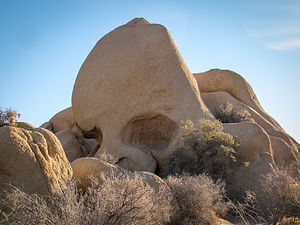 Skull RockHidden Valley was lovely, and I was starting to think that there was nothing wrong with just hiking. This was really more of a stroll though, a 1-mile loop through a small valley surrounded by colorful boulders. The valley, which really is hidden by rock, was once used by cattle and horse rustlers to graze their stolen livestock.
Skull RockHidden Valley was lovely, and I was starting to think that there was nothing wrong with just hiking. This was really more of a stroll though, a 1-mile loop through a small valley surrounded by colorful boulders. The valley, which really is hidden by rock, was once used by cattle and horse rustlers to graze their stolen livestock.
Before returning home, we did check out one more climbing area, called Echo Cove, a bit further north on the side road to Keys Ranch, because the guide book said that there was lots of opportunity for toproping. I really didn’t want my wienieness to hold Herb back from his chance to climb at Joshua Tree. Plus, the boys would be so proud if just the two of us did it.
The area actually did seem pretty interesting. Very easily approachable – you could practically belay from the car – plus there were a few 5.7s and 5.8s that Herb could set up a toprope on. This was probably our best option, so we decided to seriously consider coming back the next day to give it a try.
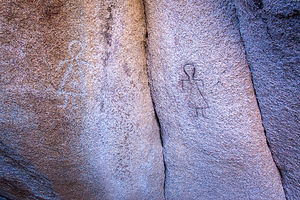 Barker Dam PetroglyphsRather than take Park Boulevard back to the campground, we took the dirt Queens Valley Road which passed through some of the park’s most impressive groves of Joshua Trees. These trees are only found at higher elevations in the Mojave Desert and we were well over 4,000 feet.
Barker Dam PetroglyphsRather than take Park Boulevard back to the campground, we took the dirt Queens Valley Road which passed through some of the park’s most impressive groves of Joshua Trees. These trees are only found at higher elevations in the Mojave Desert and we were well over 4,000 feet.
These Joshua Trees were really growing on me. Not only were they different from any other tree I’ve ever seen, but each of them was different from each other – kind of like snowflakes. However, they all have in common stubby branches that reach up towards the sky, which prompted the early Morman pioneers to name them “Joshua” trees, because they thought their branches resembled the arms of the prophet raised towards the heavens. They must have been out in the desert too long.
We had been so used to warm desert temperatures over the past week at our previous desert destinations that we were unprepared (not clothing-wise but psychologically) for how cold it got at night. Besides having a cold front move in, Jumbo Rocks Campground was at 4,400 feet, so it dropped down below freezing there at night. To make matters worse, our generator had stopped working, so we had to be somewhat conservative with the heat so that we didn’t run out of propane. Let’s just say that it was cozy. I shouldn’t complain though. At least it was better than being in a tent.
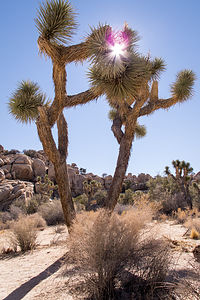 Two Joshua TreesThe Skull Rock Trail starts right in the Jumbo Rock campground, so the next morning we grabbed our cameras and set out on the trail. It was still pretty chilly, but a nice way to start the day. The 1.8-mile trail led through a maze of spectacular rock formations before finally arriving at its namesake, a massive rock in the shape of a human skull. I posed for a picture in its nostril.
Two Joshua TreesThe Skull Rock Trail starts right in the Jumbo Rock campground, so the next morning we grabbed our cameras and set out on the trail. It was still pretty chilly, but a nice way to start the day. The 1.8-mile trail led through a maze of spectacular rock formations before finally arriving at its namesake, a massive rock in the shape of a human skull. I posed for a picture in its nostril.
When we got back to the motorhome, we made a picnic lunch, gathered our climbing gear, and set out for the day. We took the unpaved Queens Valley Road short-cut again because it was more fun than staying on the main road.
We were going right past the trailhead for the Barker Dam hike, so we decided to stop and hike it. Once again, as in the other hikes we had done so far in Joshua Tree, it was short (1.3 miles), flat, and easy. However, unlike the other hikes, the attraction for this one was man-made. The dam was built over a hundred years ago by ranchers in an attempt to provide water for their livestock. The result is a small reservoir, which because of the season and the California drought, was practically dry.
Towards the end of the hike, we followed a turnoff marked petroglyphs. Usually you have to look pretty hard to see a petroglyph, because they are often faded and blend in with the rock. Well, there was nothing subtle about these. Back in the 1960s, a Hollywood film crew, thinking they weren’t bright enough, painted over them to make them more obvious. They looked ridiculous. To make it even worse, these artifacts were not vandalized in the name of a Hollywood classic, but rather for the filming of a television movie called “Chico the Misunderstood Coyote.” I have nothing more to say.
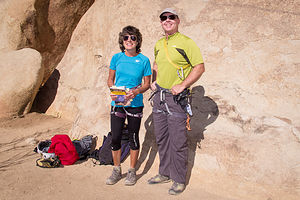 Lolo with Climbing Guide and Author Bob GainesThe day had warmed up nicely, at least when we were in the sun, so we headed over to Echo Cove to try out the climbs we had scouted out the previous day – a 5.7 climb called Swing Low for me and a 5.10d called Pinky Lee for Herb. I was glad to see that there were only two other people climbing on the wall, because I hate making a spectacle of myself.
Lolo with Climbing Guide and Author Bob GainesThe day had warmed up nicely, at least when we were in the sun, so we headed over to Echo Cove to try out the climbs we had scouted out the previous day – a 5.7 climb called Swing Low for me and a 5.10d called Pinky Lee for Herb. I was glad to see that there were only two other people climbing on the wall, because I hate making a spectacle of myself.
Unlike the men in my family, I am the kind that likes to ask for directions or have information that I am already pretty sure of confirmed, so despite the fact that I had a climbing guide book with a picture of the wall in front of me, I asked the gentleman belaying a woman to our left whether this was in fact Swing Low.
“Oh, I wrote that book,” he said glancing over at “Best Climbs in Joshua Tree” in my hand. Oh, great. Now I was going to really be self-conscious about my climbing.
When we went back to the car to get our climbing gear, I read the About the Author section of the book and became even more intimidated. This guy (Bob Gaines) was the real deal. Not only was he the owner of one of the best climbing schools in the country, but he was Sylvester Stallone’s climbing instructor for the movie Cliffhanger. Oh, and he also trains Navy Seals.
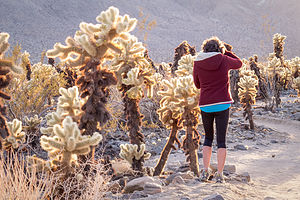 Lolo in Cholla Cactus GardenHowever, I must say that this guy was the nicest, least pretentious, and most helpful person we have ever climbed beside.
Lolo in Cholla Cactus GardenHowever, I must say that this guy was the nicest, least pretentious, and most helpful person we have ever climbed beside.
As I mentioned previously, the rock at Joshua Tree and the type of climbing it provided was very different from what we were used to. I tend to like something for my hands to grip on to. I don’t ask for much – it doesn’t have to be huge, but just something. Joshua Tree, in contrast, has a lot of crack and slab climbing, and the climb I was going to attempt, Swing Low, was a slab climb.
Just to briefly explain, a slab climb is one where the wall is not strictly vertical, but rather slopes at an angle less than 90 degrees – the lower the angle, the easier the climb. However, the holds, if they exist at all, tend to be really small, so rather than relying on your hands to give you the security and means to ascend, you use the friction of your climbing shoes to smear against the rock, and your hands are really only placed on the rock for balance.
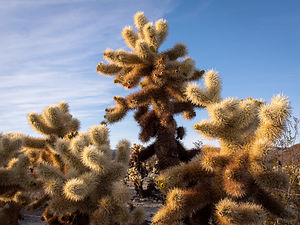 Cholla Cactus at DuskI probably was perfectly capable of doing this climb, but I psychologically freaked out. Rather than trust my feet to do the work, I frantically kept running my fingers across the wall desperately searching for something, just anything, to hold onto. It looked like I was playing the piano. After flailing and falling a few times, I finally did make it to the top, but I wasn’t very happy with myself. Thankfully, our author friend was too busy belaying his client to see my feeble attempt.
Cholla Cactus at DuskI probably was perfectly capable of doing this climb, but I psychologically freaked out. Rather than trust my feet to do the work, I frantically kept running my fingers across the wall desperately searching for something, just anything, to hold onto. It looked like I was playing the piano. After flailing and falling a few times, I finally did make it to the top, but I wasn’t very happy with myself. Thankfully, our author friend was too busy belaying his client to see my feeble attempt.
Herb did this climb quickly and easily, showing me how it could have gone if I had just used the right part of my shoes and trusted the laws of friction. I then belayed him on a more difficult climb to the right, a 5.10d called Pinky Lee. Although it was a crack climb – not one of Herb’s favorites – he did quite well and got it with just one fall.
Before leaving, however, we did get Bob to autograph the book, and Herb took a picture of me with him. He really was a nice guy and so very knowledgeable about climbing.
Up until now we had only been in the Mojave Desert section of Joshua Tree, which is cooler and wetter because of its higher elevation, so we decided to drive south down the Pinto Basin Road towards the hotter and drier Colorado Desert. As we descended, the Joshua trees began to give way to cacti and creosote bushes – such a different landscape.
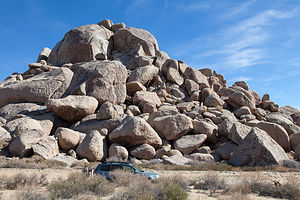 Subaru with Jumbo RocksWe stopped at the Cholla Cactus Garden, which lies in the transition zone between the two desert systems, to take the ¼-mile nature trail through a dense forest of Teddy Bear and Silver Cholla cacti. They are called Teddy Bear for a reason – not for their cuddliness, as their furry little barbs are actually quite painful, but because they are probably the most adorable cacti, or even plant, I have ever seen.
Subaru with Jumbo RocksWe stopped at the Cholla Cactus Garden, which lies in the transition zone between the two desert systems, to take the ¼-mile nature trail through a dense forest of Teddy Bear and Silver Cholla cacti. They are called Teddy Bear for a reason – not for their cuddliness, as their furry little barbs are actually quite painful, but because they are probably the most adorable cacti, or even plant, I have ever seen.
Our timing couldn’t have been any better. The late afternoon low light cast an unbelievable spell over the garden, and I would guess that Herb took more photos of these cacti than he did of me over the entire trip.
During this trip, we had really gotten an opportunity to experience just how beautiful and varied the deserts of the Southwest can be. Each of the four we had visited (Mojave Preserve, Red Rock Canyon, Death Valley, and Joshua Tree) left their own distinct impression in my mind. But we had spent 12 days in the desert, and I was beginning to dream of sea breezes and internet coverage, so we headed West towards Santa Barbara.
Description
Joshua Tree, located 2 ½ hours east of Los Angeles and 2 ½ hours northeast of San Diego, encompasses 800,000 of pristine desert, one of the last great wilderness areas in the continental U.S. Two great desert systems meet within the boundaries of the park – the cooler, wetter, and higher Mojave Desert in the northwest and the hotter and drier Colorado Desert in the southeast.
The park’s namesake Joshua Trees are found in the Mojave section of the park, where they thrive on the cooler temperatures and higher elevation. They were named “Joshua” trees by early Mormon pioneers, who thought their thick, stubby branches resembled the arms of the prophet raised towards the heavens.
There are three visitor centers, one at each of the three entrances to the park: Joshua Tree (West Entrance), Oasis (North Entrance) and Cottonwood (South Entrance). Since there are no services (food, fuel, cell phone, etc.) within the park, visitors should stock up at one of the gateway towns just outside the park.
There are two major paved roads through the park:
- Park Boulevard – 45-minute drive through the northern section of the park, which traverses the most scenic portions of the park, including sweeping desert views, Joshua trees, and unique boulder formations.
- Pinto Basin Road - connects Park Boulevard with the southern portion of the park, passing from the higher Mojave Desert into the lower Colorado Desert.
Stops and activities along Park Boulevard include:
- Trailhead for the Boys Scout Trail (South) and the 7.1 mile round trip hike to Wonderland of Rocks, a maze of jumbled granite boulders with hidden groves of Joshua trees http://www.protrails.com/trail/160/joshua-tree-national-park-willow-hole...
- Hidden Valley - 1-mile loop trail along the interior of a rock-enclosed valley. Rock climbing is popular in this area.
- Keys View – a short side trip (5 miles each way) to an overlook atop the Little San Bernardino Mountains (5,185 feet elevation) with panoramic views of the Coachella Valley and mountains beyond.
- Keys Ranch – a short side trip (2 miles each way) to a 150-acre ranch in a remote rocky canyon. Most of the original buildings – ranch house, schoolhouse, store, and workshop – have been restored to the way they were when William Keyes died in 1969. 90-minute walking tours of the ranch are offered daily.
- Trailhead for 3-mile round trip Ryan Mountain hike, a short but strenuous climb with one of the best panoramic views of Joshua Tree from its summit http://www.protrails.com/trail/155/joshua-tree-national-park-ryan-mountain
- Queen Valley – a side trip through a network of 13.4 miles of dirt roads through the park’s most impressive groves of Joshua trees. This is also the starting point for the Geology Tour Road.
- Geology Tour Road –18-mile dirt road through some of the park’s most distinctive geological formations. There are 16 stops along the way, so allow approximately 2 hours for the round trip. RVs are not allowed, but two-wheel vehicles may go as far as Squaw Tank, stop #9. After that point, only 4-wheel drive vehicles are advised.
- Jumbo Rocks – a wide plateau of boulders, buttes, and domes that glow with fiery hues at sunrise and sunset. The 1.7-mile Skull Rock Nature Loop passes through a maze of spectacular rock formations.
http://www.protrails.com/trail/349/joshua-tree-national-park-skull-rock-... - Junction with Pinto Basin Road – turn right for the Pinto Basin Road towards the southern portion of the park and left towards the North Entrance in the town of Twentynine Palms, where the Oasis Visitor Center is.
- Fortynine Palms Oasis - A short distance from the Oasis Visitor Center on Highway 62 is the turnoff for Canyon Road and the trailhead for the 3.3-mile (round trip) Fortynine Palms Oasis Trail. The moderately strenuous trail climbs up a ridge where barrel cacti grow and then descends a rocky canyon to a pool surrounded by fan palms. At dawn and dusk, bighorn sheep are often seen here.
http://www.protrails.com/trail/211/joshua-tree-national-park-forty-nine-...
Stops and activities along Pinto Basin Road include:
- Trailhead for .3-mile Arch Rock Trail – this short trail leads through a boulder garden to a natural bridge nestled between two large boulders
http://www.protrails.com/trail/213/joshua-tree-national-park-arch-rock-n... - Cholla Cactus Garden – a 1/4 -mile nature trail loops through a dense forest of Teddy Bear Cholla, Silver Cholla, and Creosote. The best time to visit is early morning and late afternoon when the cholla are backlit by the most dramatic lighting.
http://www.protrails.com/trail/265/joshua-tree-national-park-cholla-cact... - Cottonwood Spring – located just 7 miles from the southern entrance to the park. In addition to a Visitor Center, several hikes begin from Cottonwood Spring:
The 3-mile loop trail to Mastodon Peak, a large rock formation that early miners thought looked like the head of a prehistoric Mastodon, with excellent views of the Eagle Mountains and the Salton Sea.
http://www.protrails.com/trail/162/joshua-tree-national-park-mastodon-pe...The 7.2 miles roundtrip trail to the Lost Palms Oasis wherefan palms, large boulders and spring-fed pools line a deep and narrow canyon floor.
http://www.protrails.com/trail/161/joshua-tree-national-park-lost-palms-...
Activities in the park include:
- Hiking - There are more than 191 miles of hiking trails in Joshua Tree, ranging from ¼-mile nature trails to 35 mile multi-day trips. For a list of hikes see:
http://www.protrails.com/area/24/joshua-tree-national-park#Trails - Rock climbing - In addition to its namesake Joshua Trees, the park is also known for its granite boulders that attract rock climbers from around the world. There are more than 4,500 established routes in the park, ranging from bouldering for beginners in the Wonderland of Rocks to multiple pitch climbs at Saddle Rock and Echo Rock. The most famous climb is Hidden Valley’s Sport Challenge Rock.
- Mountain biking and 4-wheel driving - Check out this link for a listing of dirt roads in the park: http://www.gorp.com/parks-guide/travel-ta-joshua-tree-national-park-scen...
There are 9 campgrounds in the park (none of which have hookups)
- Black Rock Canyon Campground (reserveble) - located in the northwest corner of the park at the end of Joshua Lane, 5 miles south of the town of Yucca Valley. Campsites are located on a hillside at the mouth of a canyon surrounded by Joshua trees, cholla cactus, and various desert shrubs. Several hiking trails start from the campground. There are 100 sites for tents or RVs up to 35 feet.
- Indian Cove Campground (reservable) - located in the northern part of the park at the end of 3-mile long Indian Cove Road, 7 miles from the town of Twentynine Palms.The campground is very popular with rock climbers because it lies within the Wonderland of Rocks. There are 101 sites for tents or RVs up to 35 feet.
- Hidden Valley Campground (first-come-first-served) - located in the northern section of the park along Park Boulevard, about 14 miles south of the town of Joshua Tree. Two miles from the campground at Barker Dam is the trailhead for a one-mile loop through the Wonderland of Rocks and a small lake that reflects the rock formations. This campground is very popular with rock climbers. There are 45 sites for tents and RVs up to 25 feet (no hookups).
- Ryan Campground (first-come-first-served) - located on Park Boulevard a few miles south of Hidden Valley Campground. The best hike in the park – the three mile roundtrip to the summit of Ryan -- Mountain starts here. There are 31 sites for tents and RVs up to 25 feet (no hookups).
- Sheep Pass Group Camp (first-come-first-served) - located a few miles east of Ryan Campground. There are six group camps for tents or RVs up to 25 feet.
- Jumbo Rocks Campground (first-come-first-served) - located about 9 miles south of the town of Twentynine Palms on the Utah Trail. Its unique granite rock formations make it a very popular spot for rock climbers. At 4,400 feet, this campground is the highest campground in the park. There are 125 sites for tents and RVs up to 25 feet.
- Belle Campground (first-come-first-served) - located on the Pinto Basin Road about 1.5 miles south of the junction with the Utah Trail. There are 18 sites for tents and RVs up to 35 feet.
- White Tank Campground (first-come-first-served) - located on the Pinto Basin Road about 3 miles south of the junction with the Utah Trail. There are 15 sites for tents and RVs up to 25 feet.
- Cottonwood Campground (first-come-first-served) - located on the Pinto Basin Road about 7 miles north of the Southern Entrance. There are 62 sites for tents and RVs up to 35 feet.
- ‹ previous
- 7 of 13
- next ›
Joshua Tree National Park location map in "high definition"
Javascript is required to view this map.
